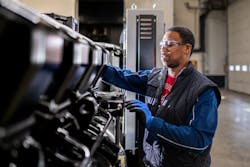Innovations in Backup Power Drive More Sustainable Solutions
While the look, feel and function of a product is certainly part of the equation, it is not the only thing to consider when trying to improve on environmentally friendly best practices.
Maintenance of a product is also another area to look at. Ensuring a products’ effectiveness is an ongoing process through its lifecycle and developments in technology are enabling these trials to not only be done more efficiently, but more environmentally friendly as well. This type of innovative thinking is a viable way for companies to inch towards incorporating green initiatives and lowering carbon emissions without having to rely on complete product overhauls to achieve their goals and objectives.
This train of thought is certainly applicable in the backup generator industry. Generators provide resiliency for customers, playing a crucial role in helping individuals and businesses maintain continuity and ensuring uninterrupted operations in the event of an unplanned power failure. However, to ensure that backup power is going to operate correctly during a loss of power, customers must perform maintenance runs and regularly exercise the machines to ensure optimal output, which can potentially come with a negative environmental impact.
For example, traditionally, customers perform loaded monthly maintenance exercises to their generators at 30% of the generators’ rated capacity to ensure that the generator reaches the required operating temperature. Optimal temperature is critical when running maintenance on a generator as it ensures that all unspent fuel is burned up, eliminating the risk of wet stacking, which is defined as the build up of hydrocarbons in the fuel system.
Wet stacking can not only lead to decreased generator performance over time, but there are also environmental implications such as black smoke or release of gasses that are not optimal. So what can be done now?
Through advancements in technology and the implementation of smart operational practices, progress is being made to provide backup power in the most sustainable way possible. Kohler Power Systems, part of Kohler Energy, is doing its part to ‘lighten the load’ on carbon emissions and recently launched Conscious Care, a new maintenance program which includes multiple maintenance protocols to help customers lower GHG emissions and reduce their carbon footprint.
Two options are now available through the Conscious Care program:
- The fuel-saving No-Load Exercise enables a diesel generator’s regular monthly exercise to be run without load and still avoid any "wet stacking". This allows customers to reduce GHG emissions by 40% per year compared to loaded cycles, while also delivering a 44% reduction in fuel consumption – therefore meeting regulations and reducing fuel costs.
- The four-month Extended Exercise goes even further. Customers can perform the test every four months with no load, reducing total GHG emissions by 69% and fuel consumption by 71%. In addition, the Conscious Care maintenance program enables an operating method that reduces noise emissions and appearance of black smoke at cold start.
Kohler has deployed the latest engine technologies on its KD Series engines to reduce the need for this costly procedure. With Conscious Care, Kohler’s diesel generators can run loaded as infrequently as once per year. If the customer chooses to use HVO fuel (Hydrotreated Vegetable Oil) instead of fossil fuel, it reduces the carbon footprint even further, by as much as 90%, throughout the product’s life cycle.
Developing innovative technologies that provide cleaner, smarter and more optimized solutions in the mission-critical power generation market is a must and the implementation of programs such as Conscious Care is a step in the right direction.
Kira Welcenbach serves as Kohler's Sr Market Research Manager, coordinating global market research efforts across the Power Systems business. Kohler Energy, a global leader in distributed energy solutions, brings bold design and powerful impact to the energy systems that sustain people and communities everywhere around the world.






